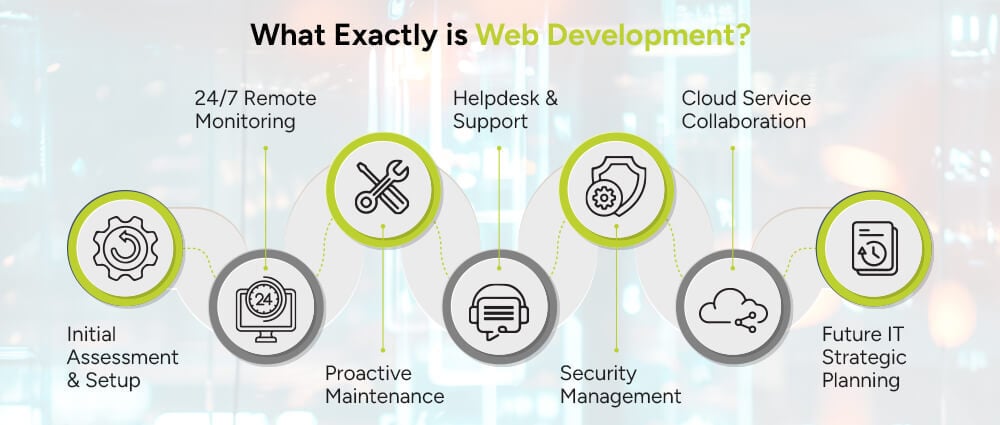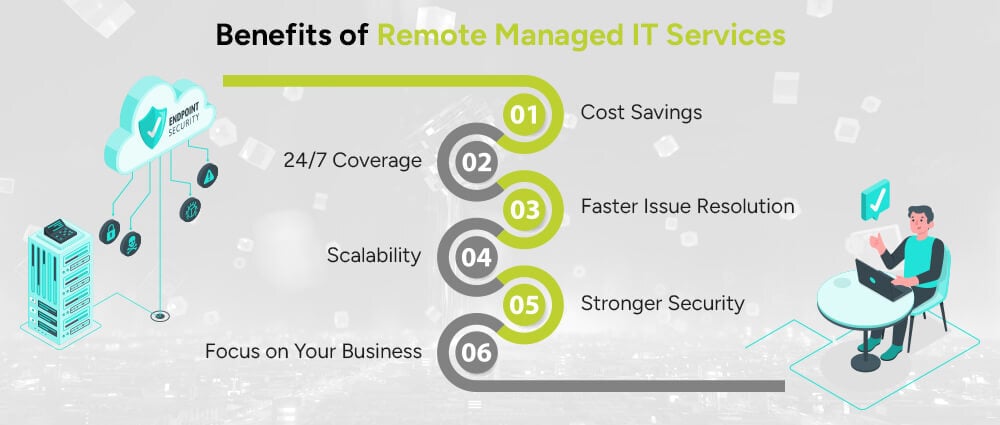Picture this: your team is working in harmony like every day, your systems are running smoothly with glitches, and then…
Suddenly, something breaks. A server crashes, emails stop working, or a strange virus appears out of nowhere!
Now imagine if someone could swoop in, fix the issue before you even notice it, and do it all without setting foot in your office.
That’s the hand of remote managed IT services.
These services offer behind-the-scenes IT support, maintenance, and security, all handled from a distance. Whether you’re running a small business or scaling fast, remote IT managed services keep your tech running smoothly, securely, and without disruption.
Remote managed IT services provide the advantage of having an IT department right at the home premises. The cost of hiring a full-fledged in-house team is exorbitant, so, it is better to hire a third-party service provider that remotely tracks, maintains, and manages the entire technology infrastructure for the company. This can include everything, from updating your software to network security, troubleshooting hardware problems, and managing cloud systems.
Such services are offered over the internet. The tools and techniques employ remote monitoring and management (RMM) for your devices, networks, and systems without the presence of someone physically in your office.

Let’s walk through how managed IT services remote work in real life:
Before anything, the provider you connect with begins by assessing your current IT environment, checking hardware, software, network setup, security vulnerabilities, and conducting a thorough assessment of the entire infrastructure. They identify all missing pieces, the security gaps, vulnerabilities, and the performance bottlenecks. Based on that, they tailor a service plan for your needs. The entire MSP onboarding process includes:
Once the systems are set up, the provider uses remote monitoring and management tools to watch over your network, servers, and endpoints. These tools detect issues like low disk space, failing hardware, or unusual network activity, often before they cause real problems.
This is called managed IT services remote monitoring and management, a key backbone of the whole process.
Regular updates, security patches, backups, and performance tuning are all handled remotely. The goal is to prevent issues before they happen, not just react to them.
When employees run into tech problems, they can contact the provider’s helpdesk for fast, remote assistance. From forgotten passwords to application crashes, the support team is just a call or ticket away.
Your remote IT team also handles antivirus updates, firewall monitoring, data encryption, and threat detection. Today, cybersecurity is a huge part of remote co-managed IT services, especially for businesses with sensitive data like Medical practice IT support.
Companies that rely on applications on the cloud, like Google Workspace, Salesforce, and Microsoft 365, your Managed IT service provider enables maintenance and integration by:
One big advantage of working with a remote managed IT services company is their proactive approach. Instead of just fixing problems, they help plan your long-term tech strategy to keep your systems up-to-date, efficient, and aligned with your business goals
To better understand how all of this works, here are some essential parts of a typical remote IT setup:
This tool keeps an eye on your computers, servers, and networks from afar.
It helps spot issues early, often before you even notice something’s wrong.
Your important files and data are saved regularly in case something goes wrong.
If there’s a crash or cyberattack, everything can be quickly restored.
Software updates and security fixes are installed automatically.
This keeps your systems safe from hackers and running smoothly.
Helps control and organize tools like Microsoft 365, Google Workspace, or cloud servers.
It makes sure everything in the cloud is secure, efficient, and easy to access.
Cubersecurity solutions includes antivirus, firewalls, and tools that protect your devices and data.
These tools guard against viruses, hacking, and other online threats.
A remote team you can contact for quick tech support.
They solve problems, answer questions, and keep your systems running.
You get regular updates showing how your IT systems are doing.
These reports help you understand performance, spot risks, and plan ahead.

So, why are more businesses turning to managed IT services remote solutions? Lets see the advantages that we get with remote IT services:
There is no need to hire or maintain a full in-house IT team, thereby incurring extra salaries, training, or office-space requirements. Remote providers offer flexible pricing models that let you pay for the services you actually use. Thus, remote IT support is an affordable and scalable solution, most suitable for small to mid-sized businesses.
Continual remote monitoring ensures that your systems are watched every hour, every day, including weekends and holidays as well as outside business hours for any anomalies or threats typically identified before they can cause real disruptions. This is because a high level of availability guarantees that performance remains uniform and possible unplanned downtimes are significantly reduced.
Remote managed IT services use monitoring tools to identify and address issues quickly, often without needing to step foot in your office. This remote approach allows for immediate troubleshooting, reducing downtime and maintaining productivity. Problems that would otherwise take hours or days to fix can be resolved within minutes.
As your business grows and your IT needs become more complex, remote IT services scale alongside you. Whether you’re onboarding new employees, expanding to new locations, or adopting new technologies, these services adjust easily. Remote co-managed IT services are particularly helpful in supporting internal teams during periods of rapid growth or transition.
Security isn’t a one-time setup; it requires continuous nurturing. Remote managed IT services offer a proactive threat-detection service, regular patching, firewall updates, anti-virus updates, and system monitoring that makes sure their clients with ongoing protection. Their aim is to obviate the potential security gaps before they transform into exploitative vulnerabilities or data breaches.
When someone else is handling your IT operations, you’re free to focus on what matters most, growing your business. You don’t have to get bogged down with technical issues, system errors, or compliance worries. With IT experts managing your infrastructure in the background, you can concentrate on strategy, innovation, and delivering value to your customers.
Remote managed IT services are like having an expert IT team without the overhead. They help businesses stay secure, efficient, and ready for growth, all from a distance. Whether you’re a small business or a growing enterprise, these services make sure your tech stays reliable while you stay focused on your goals.
Have questions about setting up your own managed IT services remote monitoring setup? Let’s talk with the IT help desk Experts at Arpatech, as we already know that the future of business IT is remote, and it’s smarter than ever.
Your business won’t stay the same size forever, and neither should your IT services. A scalable provider can:
Costs vary based on: